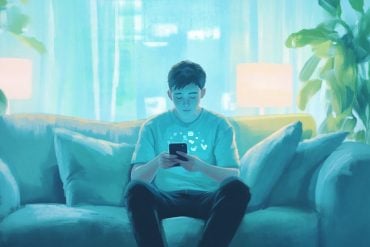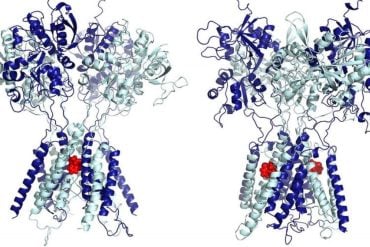Summary: 21% of veterans who experience PTSD or traumatic brain injury suffer from a rare sleep condition that affects less than 1% of the general population. The condition, REM sleep behavior disorder (RBD), is characterized by an impairment of sleep-related muscle paralysis, causing people to act out dreams during REM sleep. The uncontrolled actions often cause harm to the sufferer of their partners.
Source: Oregon Health & Sciences University
Military veterans with post-traumatic stress disorder or concussion suffer from a thrashing form of sleep behavior at a rate that is far higher than the general population, according to a new study by researchers at the VA Portland Health Care System and Oregon Health & Science University. The finding was published online this week in the journal SLEEP.
Researchers next want to probe whether the disorder, known as REM sleep behavior disorder or RBD, might provide an early signal of the development of neurodegenerative conditions such as Parkinson’s disease.
Normally during sleep that coincides with rapid eye movement, or REM sleep, muscles are effectively paralyzed. In cases of RBD, brain control of muscle paralysis is impaired, resulting in people acting out dreams during REM sleep, sometimes causing injuries to themselves or their partners. It is estimated to affect less than 1% of the general population.
That proportion rose to 9% of the 394 veterans in this study and further swelled to 21% among those with PTSD.
“This is important because, in the general population, RBD has been linked to Parkinson’s disease, and RBD often precedes classic symptoms of Parkinson’s by years,” said senior author Miranda Lim, M.D., Ph.D., a staff physician at the VA and assistant professor of neurology, medicine and behavioral neuroscience in the OHSU School of Medicine. “We don’t know whether veterans who have PTSD and higher rates of RBD will go on to develop Parkinson’s, but it is an important question we need to answer.”
Researchers suspect chronic stress on the brain may play a role in causing the sleep disorder in veterans with PTSD, as many veterans have been exposed to concussion which potentially accelerates neurodegenerative processes.
Each study participant underwent an overnight sleep study at the VA Portland Health Care System between 2015 and 2017 to determine the presence of dream enactment during episodes of REM sleep. Muscle activity was monitored continuously during the 8 hours of the study in order to diagnose RBD. The study found that those with PTSD had over 2-fold increased odds of RBD compared to veterans without PTSD.
“RBD seems to be highly prevalent in veterans with a history of trauma,” said lead author Jonathan Elliott, Ph.D., a research physiologist at the Portland VA and assistant professor of neurology in the OHSU School of Medicine.
Doctors involved in the study, including co-authors Kristianna Weymann, Ph.D., R.N., a clinical assistant professor in OHSU School of Nursing, and Dennis Pleshakov, a student at the OHSU School of Medicine, will continue to track research participants with RBD, looking for early signs of Parkinson’s or other neurodegenerative conditions.
Although there are several therapies to ease some of the symptoms of Parkinson’s, including tremor and fatigue, so far there has been no definitive therapy to prevent it.

Clinical trials for promising therapies are usually conducted well after patients have been diagnosed with Parkinson’s, at a stage which may be too late to reverse the symptoms. Lim said that identifying patients with RBD presents an opportunity to identify people earlier in the disease course, and potentially provides a more viable window to test promising interventions.
“By the time a patient shows classic symptoms of Parkinson’s, it may be too late,” Lim said. “If you could intervene when people first start to show RBD, maybe you could prevent later symptoms of Parkinson’s.”
Funding: The study was supported with resources and the use of facilities at the VA Portland Health Care System, VA Career Development Award No. 1K2 BX002712; National Institutes of Health EXITO institutional core grant No. UL1GM118964; Portland VA Research Foundation; NIH grant No. T32 AT002688; VA Career Development award No. 1K2 RX002947; OHSU Medical Research Foundation; and VA OAA Post-doctoral Nursing Research Fellowship.
Interpretations and conclusions are those of the authors and do not represent the views of the U.S. Department of Veterans Affairs or the U.S. government.
Source:
Duke Universtiy
Media Contacts:
Erik Robinson – Oregon Health & Sciences University
Image Source:
The image is in the public domain.
Original Research: Open access
“Post-traumatic stress disorder increases odds of REM sleep behavior disorder and other parasomnias in Veterans with and without comorbid traumatic brain injury”. Jonathan E Elliott, Ryan A Opel, Dennis Pleshakov, Tara Rachakonda, Alexander Q Chau, Kristianna B Weymann, Miranda M Lim.
Sleep doi:10.1093/sleep/zsz237.
Abstract
Post-traumatic stress disorder increases odds of REM sleep behavior disorder and other parasomnias in Veterans with and without comorbid traumatic brain injury
Study Objectives
Describe the crude prevalence of rapid eye movement (REM) sleep behavior disorder (RBD) following traumatic brain injury (TBI) and post-traumatic stress disorder (PTSD) in Veterans, given potential relationships between TBI, PTSD, RBD, and neurodegeneration.
Methods
Veterans (n=394; 94% male; 54.4±15.5 years of age) were prospectively/cross-sectionally recruited from the VA Portland Health Care System, and completed in-lab video-polysomnography and questionnaires. TBI and PTSD was assessed via diagnostic screening and medical record review. Subjects were categorized into 4-groups after assessment of REM sleep without atonia (RSWA) and self-reported dream enactment: 1) “Normal,” neither RSWA nor dream enactment, 2) “Other Parasomnia,” dream enactment without RSWA, 3) “RSWA,” isolated-RSWA without dream enactment, and 4) “RBD,” RSWA with dream enactment. Crude prevalence, prevalence odds ratio, and prevalence rate for parasomnias across subjects with TBI and/or PTSD was assessed.
Results
Overall prevalence rates were 31%, 7% and 9% for Other Parasomnia, RSWA, and RBD, respectively. The prevalence rate of RBD increased to 15% in PTSD subjects [(age adjusted POR: 2.81 (1.17-4.66)] and to 21% in TBI+PTSD subjects [(age adjusted POR: 3.43 (1.20-9.35)]. No subjects met all diagnostic criteria for trauma-associated sleep disorder (TASD), and no overt dream enactment was captured on video.
Conclusions
The prevalence of RBD and related parasomnias is significantly higher in Veterans compared to the general population, and are associated with PTSD and TBI+PTSD. Considering the association between idiopathic-RBD and synucleinopathy, it remains unclear whether RBD (and potentially TASD) associated with PTSD or TBI+PTSD similarly increases risk for long-term neurologic sequelae.






